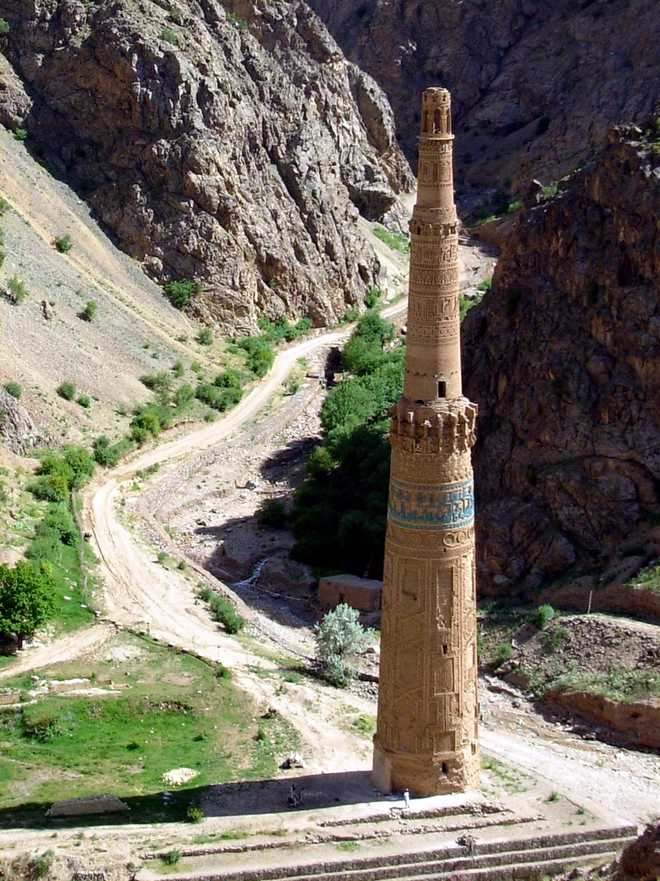Kanwarjit Singh Kang
The nearly four decades of conflict and political instability in Afghanistan has led to the destruction of most of its historical monuments. Some of these have, however, been lucky enough to survive. The most prominent among these is the Minaret of Jam.
Included in Unesco’s World Heritage list, Minaret of Jam belongs to a group of around 60 minarets and towers, which are said to have been erected between the 11th and the 13th centuries in Central Asia, Iran and Afghanistan.
Located in the Shahrak district in the Ghor province of Afghanistan, the minaret stands near the confluence of Hari and Jam rivers, which flow rapidly in the rocky valley of mountains rising 2,300 m above the sea level. It is believed to be situated at the place that was known as Firuzkuh or Firuz Koh, summer capital of the Ghurid dynasty, which was destroyed by Changez Khan in 1222. The Ghurid empire flourished between 12th and 13th centuries. At its zenith, it ruled over a vast area, which included present-day Afghanistan and eastern Iran, along with northern parts of India and Pakistan.
At a height of nearly 65 meters, the minaret is considered to be one of the finest examples of Islamic architecture. Built with backed bricks and lime mortar, it stands on a base which is shaped like an octagon and consists of four cylindrical shafts resting on top of one another. These get progressively smaller as they get higher. The entrance is made through a set of double helicoidally stairways that start from the base and ascent steeply in a circular way. A lantern, now nearly collapsed, crowns the summit above the two balconies with ruined corbels.
The outer surface of the minaret is covered with complex decorations in the form of relief work and bas-reliefs; wrapped up in floral brickwork and turquoise-glazed epigraphic bands. It appears that the glazed tiles, with which the inscriptions are highlighted, were used in order to make these more visible for the reader. All the inscriptions, except one, are written in Kufic, the oldest form of Arabic script. One inscription manifesting the architect’s name or signature — Ali ibn Ibrahim al-Nisaburi — is in Nakshi or cursive script. This suggests that Ali was from the eastern Iranian town of Nishapur. According to one inscription, the minaret was erected by Sultan Ghiyas ud-Din Muhammad ben Sam Ghuri (1163-1203), the ruler of Ghor. There has been a debate over the date of construction of the minaret. It was built, in all probability, around 1194.
A topographical and archaeological survey of the site showed in the immediate neighbourhood of the minaret the ruins of a citadel, which gives impression that the minaret was not surrounded by a city but by a fortified military camp. A water reservoir lies about 400 m above the Hari river. Two pipes, made of clay, protrude from the reservoir. It is assumed that these underground pipes, which were directed towards the citadel, supplied water in times of war.
Archaeologists and historians have wondered about the purpose of erecting this minaret. The possibility of its having been attached to a mosque is meagre because the space near the minaret is not enough to accommodate a mosque. Maybe it was a victory tower built to commemorate some forgotten event.
The Ghurids, who were great patrons of Persian architecture, transferred it to India also, of which several examples have survived. According to some scholars, the builders of Qutab Minar at Delhi, which was begun in 1199, were inspired, in part, by the minaret of Jam. In a lighter vein, it is sometimes referred to as the ‘elder brother of Qutab Minar’.
The minaret is threatened by water penetration from Jam and Hari rivers, leading to the north leaning of the minaret towards the Hari river. The minaret is slightly in a sloping position and Afghanistan is prone to experience earthquakes. No wonder then, Unesco has included it in its list of World Heritage in Danger.
Unlock Exclusive Insights with The Tribune Premium
Take your experience further with Premium access.
Thought-provoking Opinions, Expert Analysis, In-depth Insights and other Member Only Benefits
Already a Member? Sign In Now










